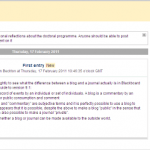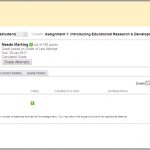I’ve been getting more and more interested in “lecture capture” systems of late. These are systems that record a lecture on video, “chunk” it into sections and stream it to a virtual learning environment such as Blackboard. Clearly, this has the potential to go some way beyond the current practice of posting a set of PowerPoint slides on Blackboard, and leaving it at that. Of course, some colleagues at Lincoln have been experimenting with recording lectures, but the need to install appropriate software, marry audio and slides, secure recording equipment, and find a place to post it, mean that this is unlikely to be sustainable on an institutional scale.
What is interesting about lecture capture systems is that they don’t require a great investment in hardware. Panopto, for example, simply makes use of existing computers, web cams and microphones, and the quality of the end product is apparently quite good. (Although, I have to say the sound quality on their demonstration videos was dreadful on my PC, which didn’t inspire confidence.) This post though, isn’t about the technology or the cost, important though those matters are, but more about the pedagogical implications. I have a feeling that many colleagues will be rather nervous at the idea of recording lectures. Surely, they will ask, if students know that the lecture is recorded, they won’t come at all. Not only that, once the lecture is in the can as it were, why would the University continue to employ them?
Well, I could give a flippant answer, and point out that any teacher who can be replaced by a machine probably should be, but I suspect that would not be helpful. So here’s some evidence from the sector.
At Aberystwyth, as of Winter 2010, there were more than 18 different modules using Panopto… A student survey conducted in December 2009 found that students view Panopto as a great tool for reviewing course material and studying for exams.
At Northampton, the first two departments to trial Panopto were the Business School and the School of Health. Lecturers and tutors got involved and were surprised at how easy Panopto was to use. They also loved the fact that it integrated seamlessly with Blackboard. Di Stoncel, Principal Lecturer in the School of Education, made a recording of a guest speaker, which was then broadcast to students, with great success. She said “I have found it to be very useful and easier to use than I expected…It is unobtrusive and has opened up several opportunities which have enhanced the student experience.
Admittedly, the above examples are taken from Panopto’s own publicity material, but at a recent meeting at Loughborough (which uses a different system, Echo360) several speakers claimed that attendance had gone up at lectures, student satisfaction was increased, and, (probably something of a by product) the sartorial standards of teaching staff had dramatically increased! The main issue was simply ensuring that lecturers stayed within the camera’s viewpoint.
While I haven’t looked at this in any detail, I noticed that both Panoptico and Echo360 seem to have open APIs, which suggests that we might be able to do all sorts of interesting things with the data they generate. By “we” of course, I mean “people who know about this sort of thing”.
So, I don’t think lecture capture is necessarily anything to be afraid of. Clearly, further investigation is needed, something I propose to do. There’s an event in London next month, which I plan to attend, and if I am able to do so, will blog about it. So watch this space.



You must be logged in to post a comment.